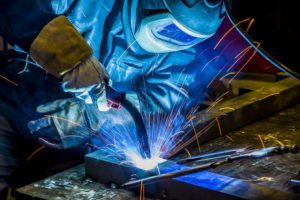Stainless steel is one of the most popular metals used in the construction industry because of its strength and versatility. It comes in many different sizes and lengths which is why it’s common for workers to have to weld pieces together during a project. The welding process gives off fumes which can be dangerous both for workers and for anyone else on the site. While we’re proud to offer a wide range of steel fabrication services we’re highly aware of the need for safety. As a result, we’ve put together some hints and tips for staying safe when you’re welding stainless steel. But first of all, let’s look at why welding is potentially dangerous.
What’s so dangerous about welding?
So that two pieces of stainless steel can be joined together successfully, both the metal and the filler material are heated together at exceptionally high temperatures. This causes large quantities of fine particles and vapours to be released into the air during the procedure – and many of these are dangerous for humans. The toxic fumes which can be released during the manual arc welding process include:
- Metal oxides
- Fluorides
- Silicates
The most toxic of these is chromium (V1) which is a carcinogen (or something which could cause you to develop cancer). Exposure to carcinogens such as these can cause severe irritation to your skin, eyes, throat, nose, and lungs. Tiny amounts of metal additives are also released such as copper, manganese, vanadium, nickel, titanium, and more. It’s vital that welders are properly protected from the harmful elements of welding and, wherever possible, welding should be carried out in a separate area, safely away from other workers.
Welding coated or painted stainless steel
Workers need to be aware of zinc oxide fumes when working with galvanised stainless steel. If they were to breathe in these fumes it could cause symptoms which are similar to flu, such as dizziness, nausea, fever, lethargy etc.
However, when working with paint-coated stainless steel, it’s important to know that the resulting fumes also contain lead oxide. This can cause damage to the central nervous system, kidneys, and reproductive system as well as lead poisoning.
Where possible, it’s best to remove any paint or coating from the area that is to be welded by using an angle grinder and flap disc. This lowers the level of hazardous vapours that are released during welding.
While the initial exposure to welding fumes causes mild to moderate effects, in the longer term the effects can be devastating. As well as damaging vital organs, welders can also develop a variety of cancers due to exposure to UV radiation and welding fumes.
How to maximise safety during welding
- Alternative methods – reducing the power output lowers the level of fumes but you could also consider a method of welding known as TIG (Tungsten Inert Gas) which produces the lowest level of fumes released by all types of welding.
- Ventilation – Never rely just on natural ventilation – instead use local exhaust systems or consider using a ventilated workbench.
- PPE Equipment – Always wear protective clothing which should be made from non-flammable materials and cover every part of your body. You should also wear a full-face welding helmet which is fitted with a UV filtered lens as well as steel capped boots and flame-resistant gloves.
- Share the job – In order to minimise your exposure to harmful fumes, consider sharing the job with your colleagues. If there are several welders working in the same area, then welding screens should also be used.
Stay Safe on the Job
We can’t stress enough the importance of constantly being aware of the dangers of welding. By following recommended guidelines for safety, wearing the appropriate PPE gear, and ensuring correct ventilation, you can get the job done safely while minimising risks to your health.
If you have any questions about stainless steel or welding safety or would like to enquire about our stainless-steel products and services then please get in touch with the experts at Metro Steel by calling 07 3204 1000.
 Talk to an Expert (07) 3204 1000
Talk to an Expert (07) 3204 1000 Working Hours - Mon – Fri 7:00 AM – 4:00 PM
Working Hours - Mon – Fri 7:00 AM – 4:00 PM
